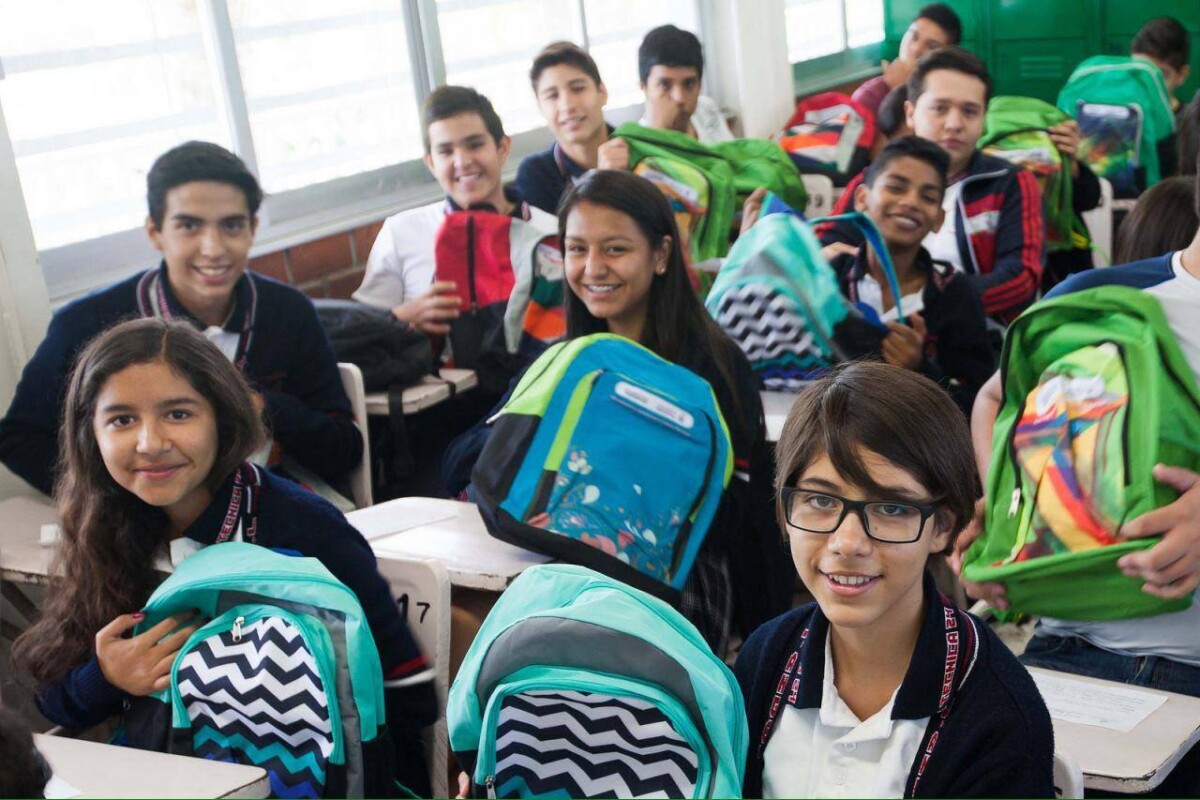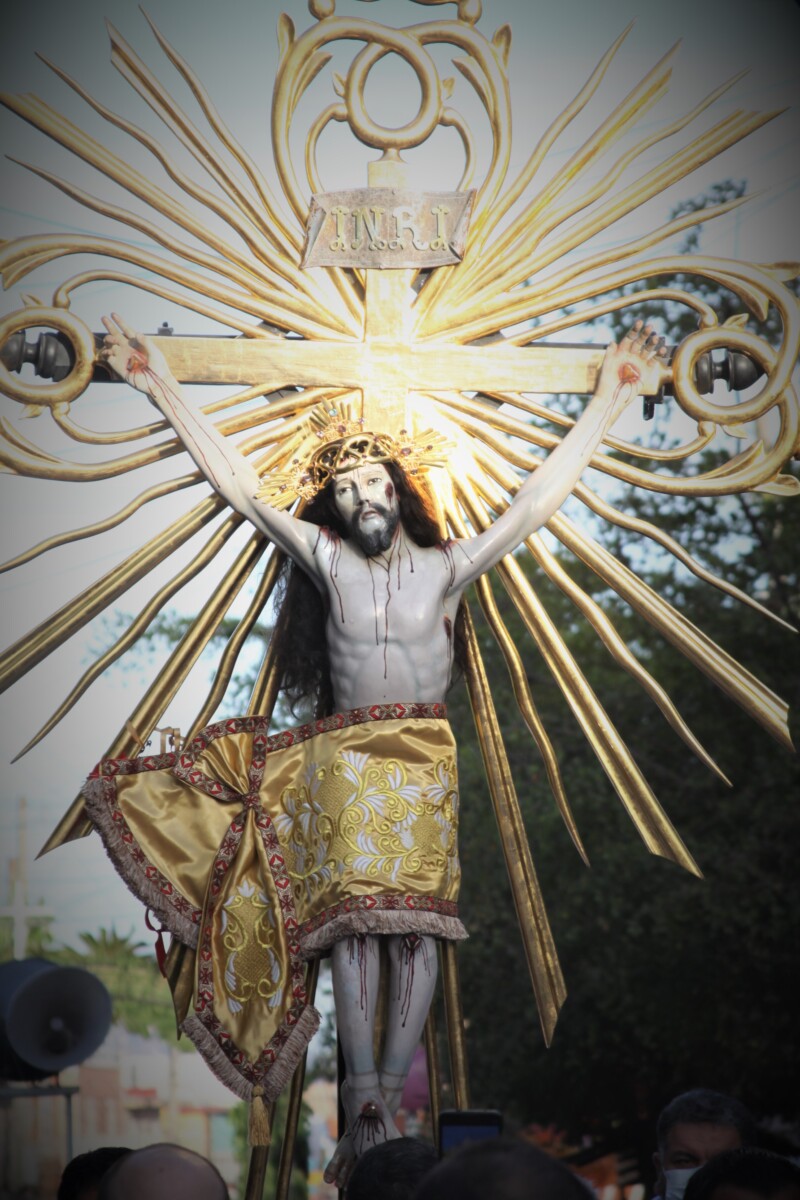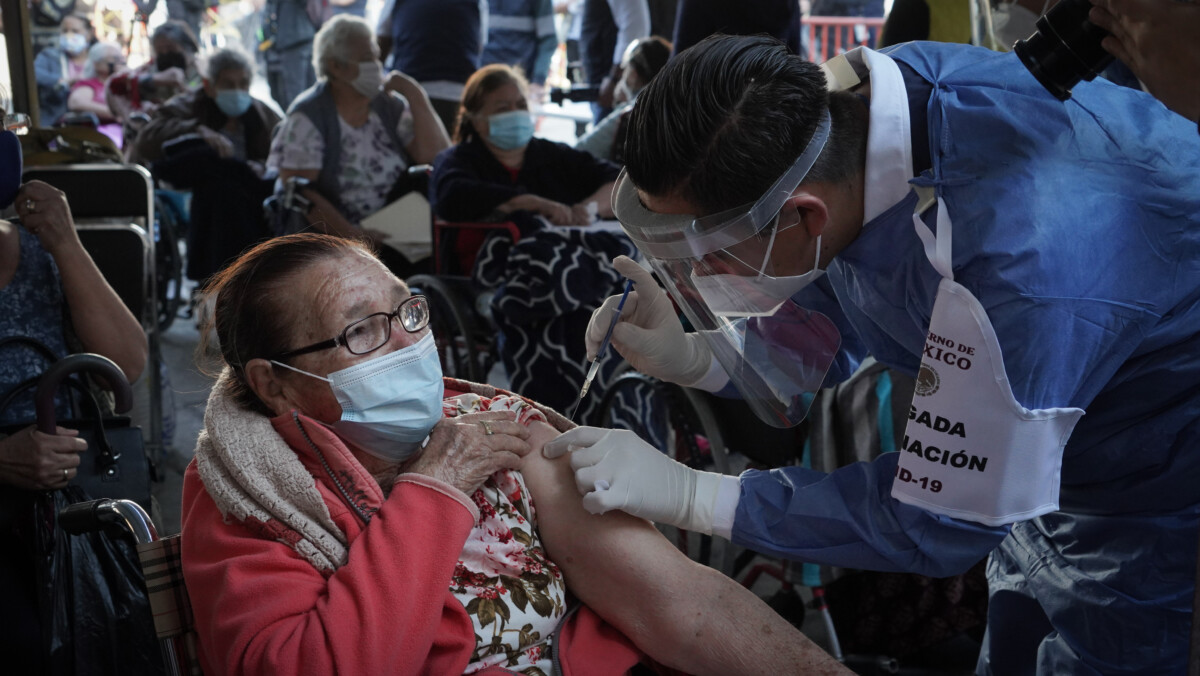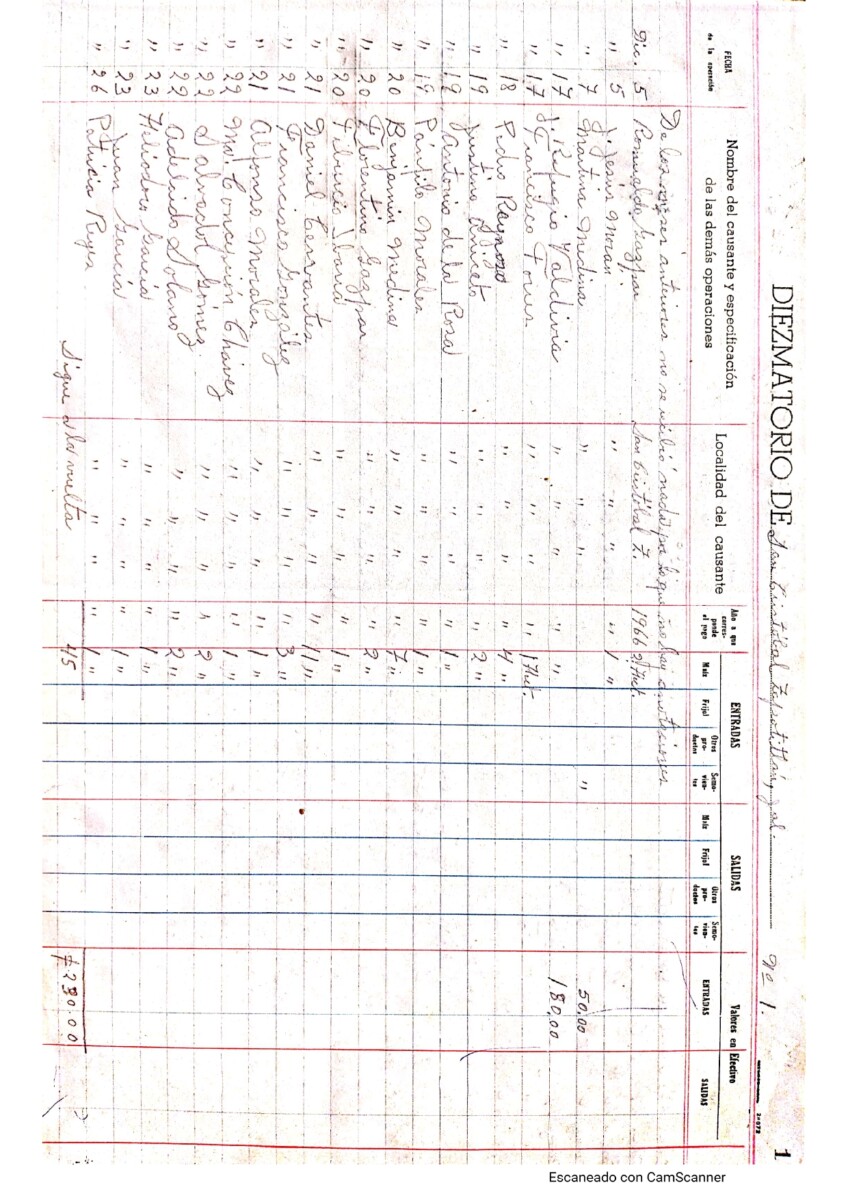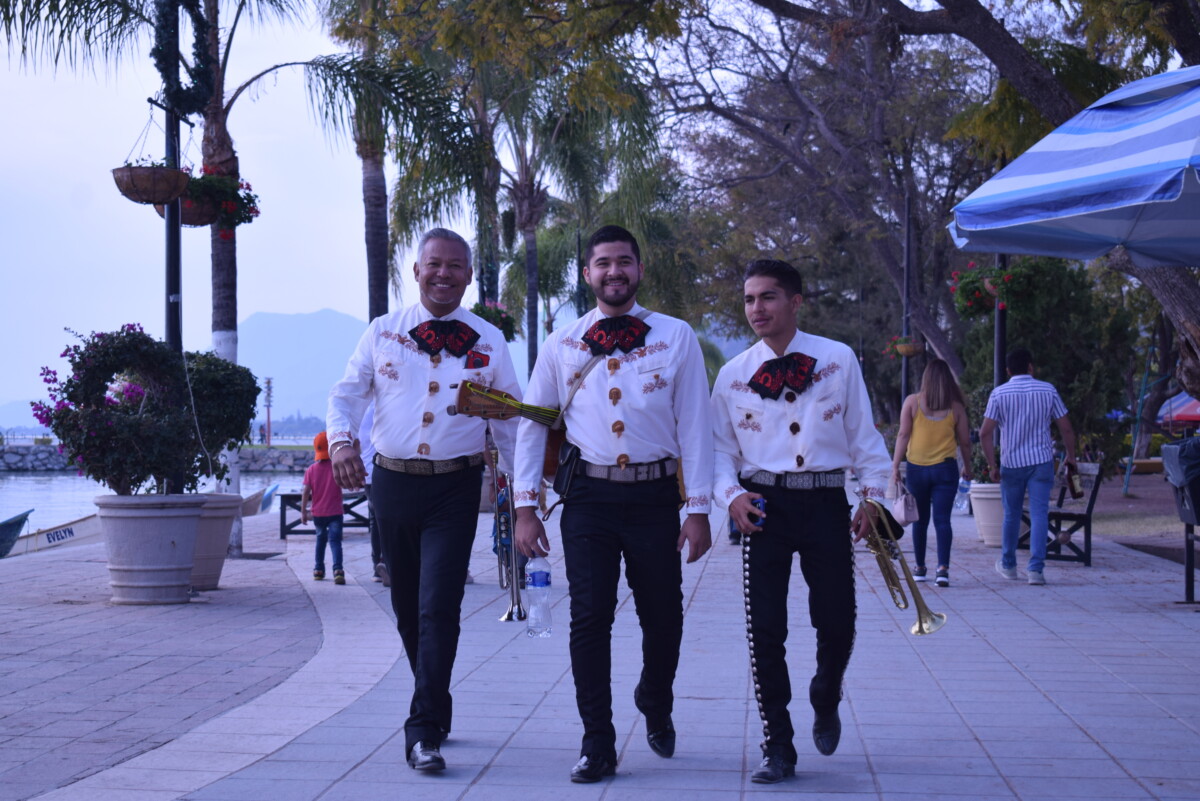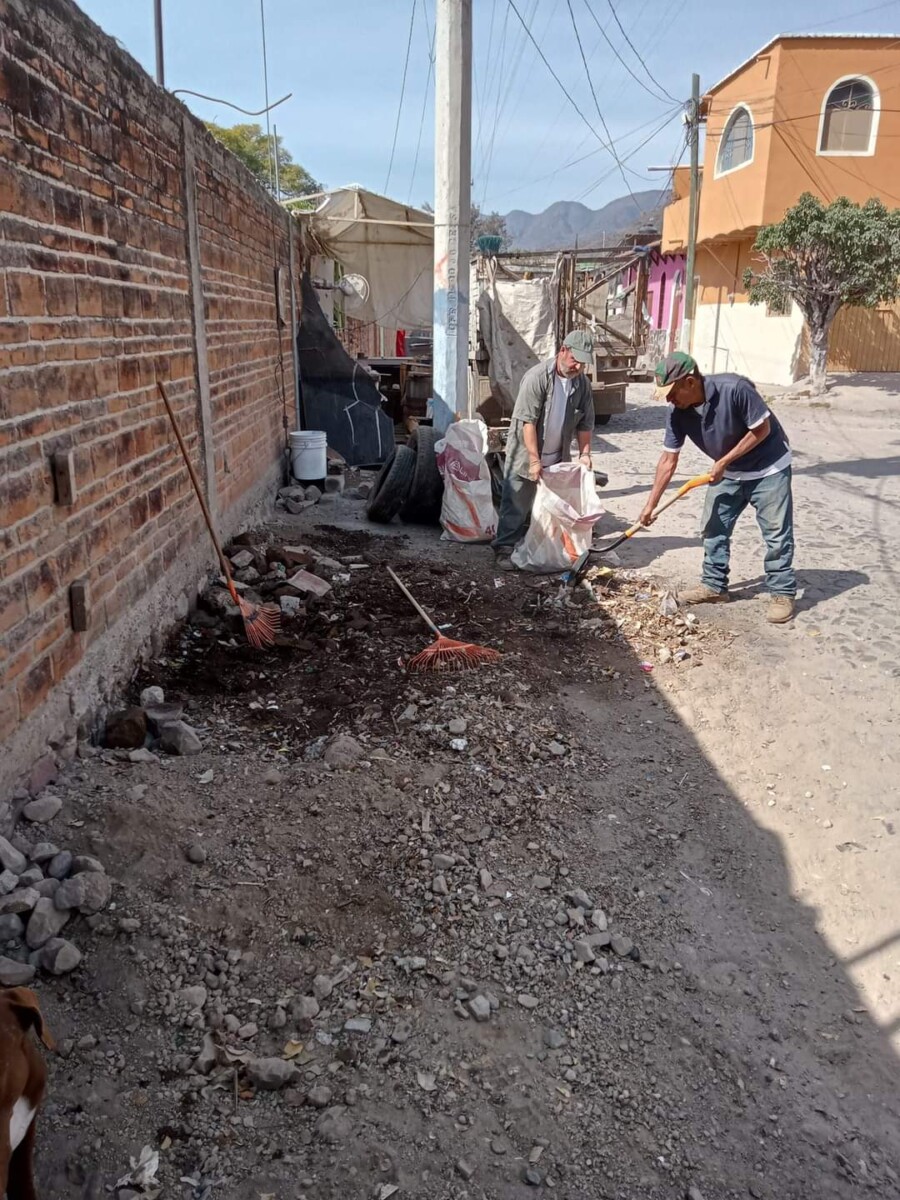Localidades
Scholarship program benefits less than one percent of Jocotepec children
In Jocotepec alone, 9,100 children make up the basic education payroll. Photo: Courtesy.
Héctor Ruiz Mejía – Not even one percent of children in the municipality of Jocotepec benefited from the Jalisco Scholarship program, according to personnel from the Jalisco Ministry of Education (SEJ).
According to the SEJ, of the 12,106 scholarships awarded in 2021, only 106 went to children in the municipality of Jocotepec, representing just 0.84 percent of the total support granted to the state. In other words, of the approximately 9,100 children registered in the municipality’s basic education system, only 1.16 percent had access to the annual support.
The educational authorities of the lakeside municipality noted that this is a troubling situation, because although no precise data are available, they know from experience that there are many children who need support to continue or complete their studies.
Part of the problem, according to the municipality’s educational personnel, is that a considerable number of the applications do not meet the requirements and so do not qualify for the support. «We try to check that all the documentation is in order before passing it on to the person in charge, but in many cases the parents have failed to provide even proof of studies or proof of address,» said the representative, who preferred to remain anonymous.
Not meeting the requirements is one of the main reasons why the applications have been rejected. «We help with the processing of a thousand applications, however, for various reasons such as non-compliance with the paperwork, only 100 of these are approved» he explained.
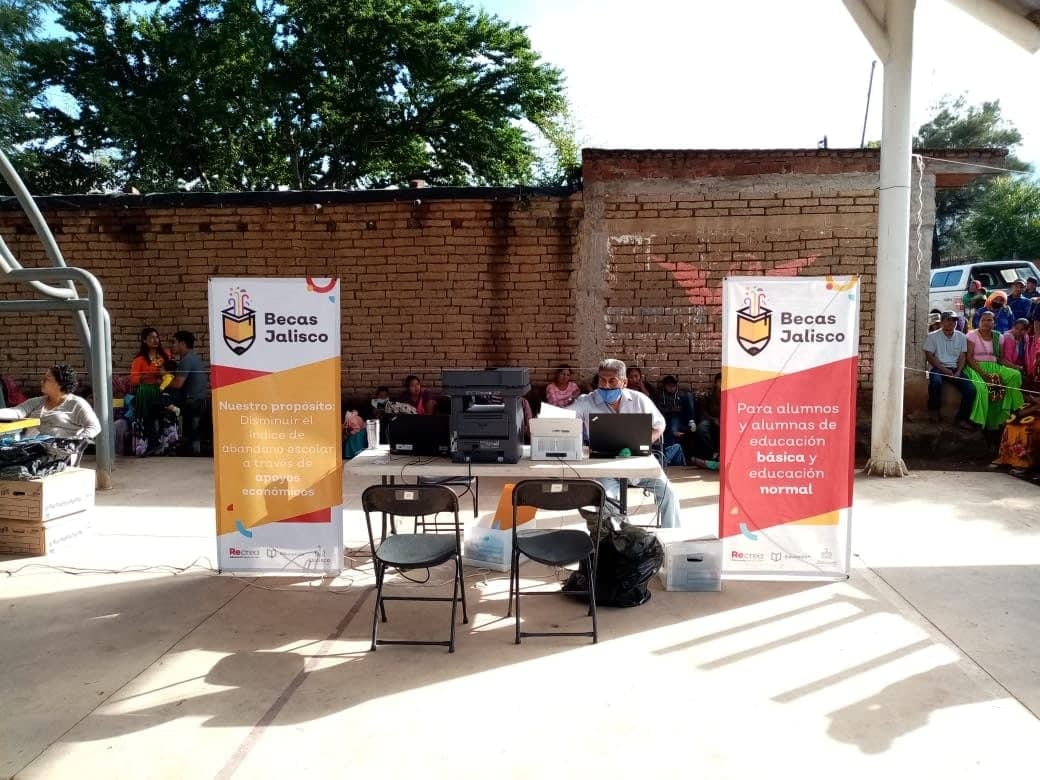
Education authorities regret the low percentage of children receiving economic support. Photo: Courtesy.
The representative also made it clear that the low budget allocated to education programs is an ongoing obstacle to providing adequate support to the children and young people who need it to complete their studies.
In his most recent visit to Jocotepec, Jalisco Director of Focus and Follow-up of the Ministry of Education (SEJ Fernando Lozano Morales met with municipal education authorities to speak about the situation. He acknowledged the precarious financial situation due to the federal budget cuts, but also reminded those present that Becas Jalisco (Scholarships Jalisco) is one of the few support programs to survive the cutbacks.
Furthermore, Fernando Lozano assured that despite current budgetary challenges, the amount allocated this year to the program will be triple the previous budget. This year’s goal is to provide access to funding for more families in a vulnerable economic situation in the lakeside municipality.
The Jalisco Scholarship Program was established as part of a strategy to prevent students from dropping out of school solely due to their families’ economic situation. The support consists of a one-time (annual) payment exclusively for children in basic education; funding is available for 1,800 students for the period January – June, and for 1,200 students for the period September – December.
Translated by Rebecca Zittle
Lakeside Chronicles
The Señor del Monte religious festival has filled the streets of Jocotepec for more than 180 years on the third Sunday of January.
By María del Refugio Reynozo Medina
That time long ago, we could not even reach the threshold of the parish; Juan Pablo and I got lost in the human tide that swirled around the statue of the Señor del Monte. We were going against the current; after the rubbing of sweaty bodies in which we could even feel each other’s ribs, we returned to the little truck that had taken us there and was about to leave us. We could not see the Señor del Monte.
More than 20 years have passed since that day. Today, half an hour before the start of the procession, the atrium begins to receive the pilgrims who continue to arrive, but do not flood the enclosure. According to some parishioners, this year there was half the attendance compared to the years without the Covid-19 pandemic. Some five thousand people this year, according to data from the Civil Protection Office of the municipality of Jocotepec.
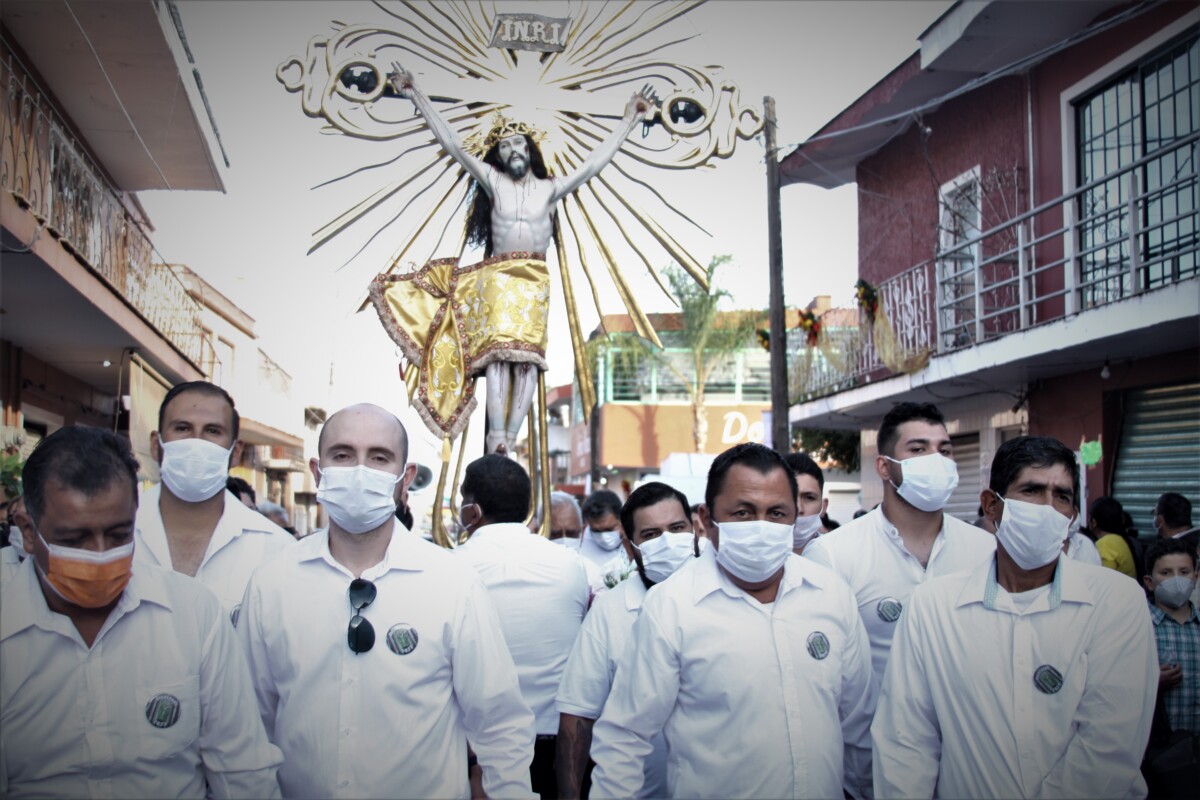
The positions of the honor guard are inherited from generation to generation to the firstborn.
In the temple, the members of the honor guard are already behind closed doors preparing the Señor del Monte for his journey, as has happened every third Sunday of January for more than 180 years.
The Jocotepec chronicler Manuel Flores Jiménez, marks the year 1834 as the first occasion that the ancestors celebrated his «miracle,» then November 8, 1833, as the date in which they also congregated, to swear in writing to take him as the patron saint of their lives. In 1918 the oath was renewed.
The honor guard is composed only of men, all direct descendants of those who took the original oath. There are about 150; most are adults, the youngest is 11 years old. They are grouped by families, each one with a specific task such as organization, preparation of the image for its journey and care and custody of the patron during the procession.
Belonging to the honor guard is a privilege that is inherited from generation to generation and becomes a gift that arrives by destiny.

Some people advance to meet the procession kneeling to give thanks for favors received or to ask for help from the Señor del Monte.
The men of the honor guard are dressed in white shirts, surrounding the image that has already been taken down from the altar, and finish preparing it for its procession. There are few women in the place; not even ten, they are direct relatives of the members of the honor guard. It was not until about ten years ago that women were allowed to enter.
The Lord of the baptistery is already downstairs, as his ancestors called him before he became their official patron saint, according to the records of the chronicler Flores Jiménez.
The Christ directs his gaze to the sky with half-open lips, has a sharp nose, beard and black hair. He has his arms extended on the wooden cross that appears to shine; that cross «morena de sol» as father Benjamín Sánchez calls it in the Romancero de la vía dolorosa, is bordered with golden rays.
The Señor del Monte wears a coppery cloth with rich embroidery, and on his head, a splendorous crown made of prayers always heard, because «this Lord is very prodigious.»
“I am one of his miracles,» says Manuel Ibarra, who emerged victorious from a cancer diagnosis. Before going to the hospital, he prayed to the Señor del Monte for his health and touched the body of the Christ figure with a piece of absorbent cotton, to carry it with him in the battle against the disease. That was 12 years ago.
Jésus Pérez is the grandson of Cándido Pérez, the latter was present at that historic oath and appears in a painting, «The Oath» which is in the sacristy of the parish. Now Mr. Jésus participates with his son Óscar Pérez and his grandson Alejandro Pérez.
Minutes away from the beginning, the bells toll with a festive flavor, a human fence begins to form and dozens of eyes look anxiously at the huge wooden door.
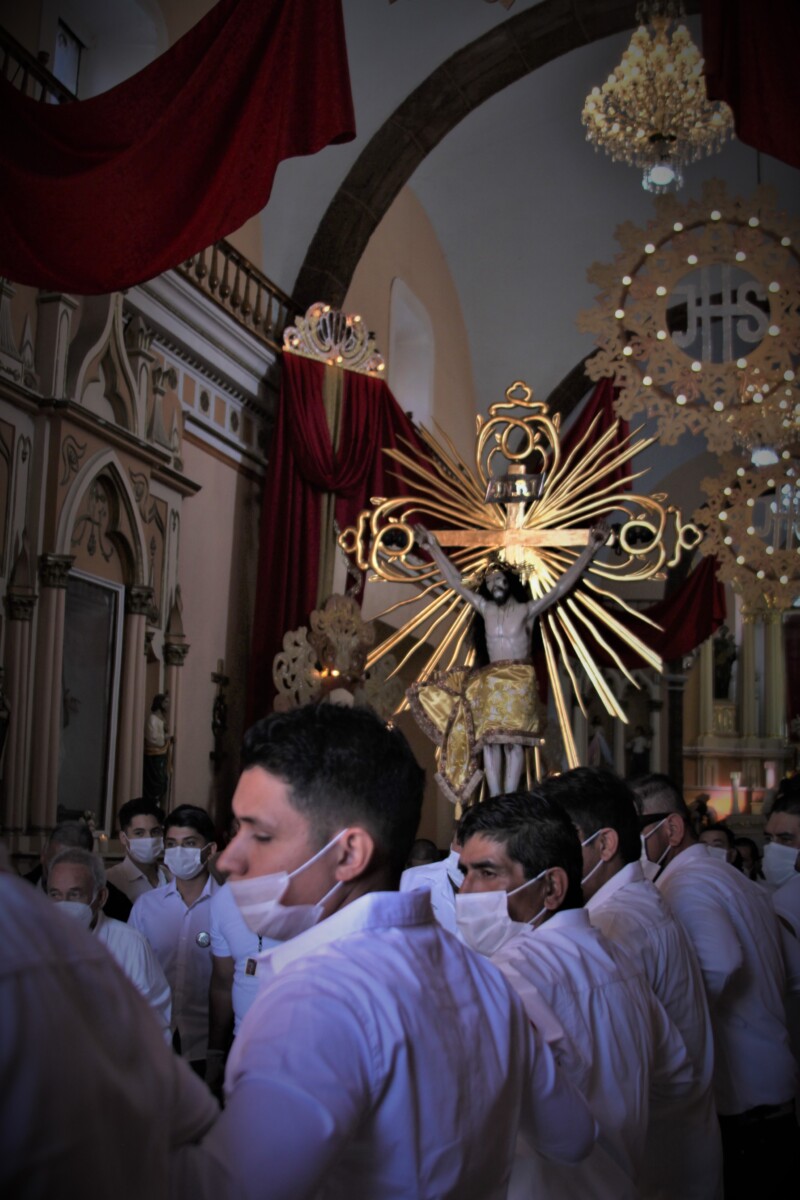
The men of the honor guard intertwine hands to leave the temple with the image at the beginning of the procession.
-Long live the Señor del Monte!» shouts a man’s voice, seconded by another female voice.
-Long live! ¡Viva!
The fervent voices respond and the door opens.
The faithful crowd moves to meet the crucified Christ. The drums of the dancers sound and the pilgrimage begins.
Leading the procession is a girl of about five years old dressed as a dancer, she emulates the steps of her elders and glides safely across the width of the street.
A man and a woman wear white t-shirts with «Danza por manda» written in black letters. With them are more people who dance throughout the procession in orderly rows. There is also the marching band, a young man on stilts who helps with the order of the walkers, and a mariachi band.
A female voice prays the rosary and sings over a loudspeaker from a cart.
Some streets are adorned with bows of red and yellow satin ribbon, also with arches of fresh flowers.
The Señor del Monte is carried by a guard of 20 men, one of them walks backwards, every so often along the way they are exchanged for another group of 20. Five guard changes are made along the pilgrimage, in total there are one hundred men who help carry the patron saint.
«Vivas!» to the Señor del Monte are heard along the route, tearful eyes seek the face of the crucified, there are many tears shed, many prayers in silence, which are announced by the tearful look of those who come out in their path.
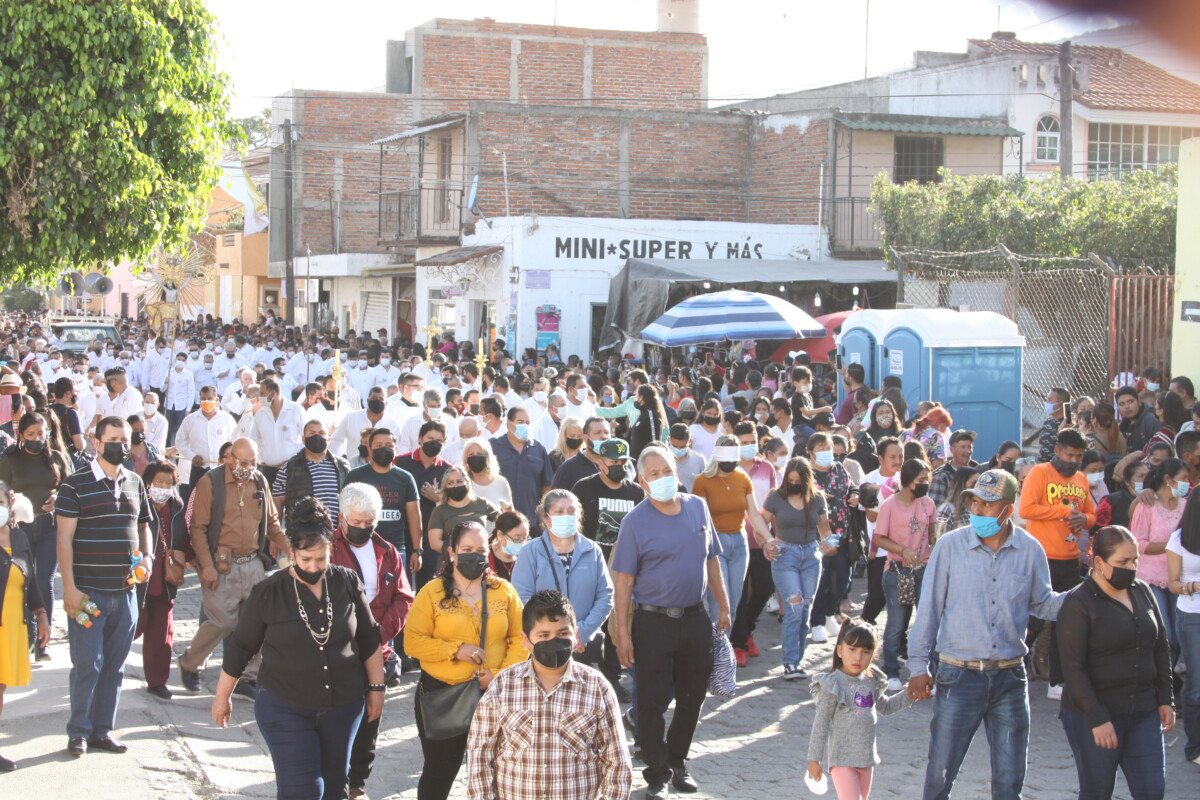
With the attendance of about five thousand people, according to data from the Civil Protection Department of Jocotepec, the procession in honor of the Señor del Monte took place.
Some people go barefoot and blindfolded; a line of men and women who advance kneeling in the opposite direction to the procession, go to meet the image, supported by folded blankets thrown on the floor.
Civil Protection officers watch over those who are kneeling and help them to get back up.
The khaki uniforms of the officers and their yellow helmets contrast with the brightly buttoned suits of the mariachis and the white shirts of the guardians of the faith.
The officers, the faithful, musicians, and priests all converge in an ancestral procession, dedicated to that ancient Lord of the baptistery who summons thousands because his presence radiates something indescribable.
Translated by Kerry Watson
Fotonota: Baja Chapala su nivel
Foto: El lago de Chapala. Foto: Héctor Ruíz.
Redacción. – El lago de Chapala ha perdido 16 centímetros en esta temporada de estiaje, informó la Comisión Nacional del Agua (Conagua) Jalisco.
El vaso lacustre se encuentra al 73 % de su capacidad, mientras que las presas cuentan con 87% de almacenamiento.
Lo detienen por violencia familiar
Patrulla de la Fiscalía del Estado de Jalisco. La fotografía no pertenece a los hechos descritos en la nota, la imagen se utiliza sólo con fines ilustrativos. Juan Gabriel R., pues contaba con un mandato judicial emitido por el Juez de Control y Juicio Oral del Quinto Distrito Judicial con sede en Chapala
Redacción. – Por los delitos de violencia familiar y lesiones calificadas detienen a Juan Gabriel R, informó la Fiscalía Regional.
El masculino fue capturado cuando se hallaba en la calle Francisco I. Madero y la calle Obregón en el poblado de San Nicolás de Ibarra, en Chapala y se le relaciona con eventos que fueron denunciados ante la Fiscalía en el año 2021.
Medio millón de personas han recibido la vacuna de refuerzo contra COVID-19 en Jalisco
De las 500 mil vacunas, 380 mil 011 corresponden a personas de la tercera edad. Foto: SSJ.
Redacción.- Más de medio millón de personas en Jalisco ya han recibido la vacuna de refuerzo contra COVID-19, sea la tercera dosis para quienes se pusieron esquema doble o la segunda para quienes recibieron unidosis en su esquema original, registrándose el avance más sustancial en mayores de 60 años y en trabajadores del sector educativo.
A la fecha suman 560 mil 421 jaliscienses que ya cuentan con dosis de refuerzo, tanto vecinos del Área Metropolitana de Guadalajara (AMG), como de municipios de todo el territorio estatal; de los cuales 380 mil 011 son personas de la tercera edad y 107 mil 567 trabajadores de la educación. Asimismo, se ha protegido a 61 mil 773 trabajadores del sector salud y el resto corresponde a las personas de 50 a 59 años, grupo que la semana pasada comenzó a recibir el refuerzo.
Del lunes 17 al sábado 22 de enero (semana epidemiológica 3 del 2022) fueron aplicadas 171 mil 948 dosis de la farmacéutica AstraZeneca; 9 mil 330 dosis de laboratorios Pfizer-BioNTech; 4 mil 997 producidas por Moderna, 3 mil 075 de Sinovac y 744 de Cansino.
Esta semana, en Jalisco se estarán suministrando vacunas a cinco grupos: refuerzos a mayores de 40 años, segundas dosis a mayores de 18 años, primeras y segundas dosis a adolescentes de 14 a 17 años y primeras dosis a adultos rezagados. Además, se abrirá el sistema de citas para diversos sectores de población.
Por el delito de desaparición, permanecerá en prisión preventiva
Un hombre esposado. Fotografía con fines ilustrativos.
Redacción.- Por su probable participación en el delito de desaparición, Ernesto P permanecerá un año en prisión preventiva como medida cautelar, informó la Fiscalía Especial en Personas Desaparecidas (FEPD) del Estado.
El sujeto presumiblemente está relacionado con la desaparición de un hombre el 29 de diciembre del año 2019, en el municipio de Chapala.
De las investigaciones realizadas por el personal de la FEPD se desprende que ese día, el imputado llegó al domicilio de la víctima ubicado en el poblado Puerta del Horno, de ahí salieron juntos, sin avisar rumbo y destino.
La familia se percató de la ausencia de su hijo de 26 años de edad que no retornaba a casa, por lo que de inmediato fueron a buscarlo al domicilio del señalado, quien manifestó desconocer su paradero.
Posteriormente los padres acudieron ante esta representación social a presentar una denuncia por su desaparición. Una vez que se obtuvieron datos de prueba se logró identificar a Ernesto P. como el probable partícipe en el hecho, por lo que fue detenido mediante orden de aprehensión, por el delito de desaparición cometida por particulares agravada.
Chronicles of La Ribera:
By: María del Refugio Reynozo Medina
The original tithe ledger where the contributions pledged by the parishioners were recorded. Photo: María del Refugio Reynozo Medina. Courtesy Historical Archive of the parish of San Cristóbal Zapotitlán.
«Honor the LORD with your possessions and with the first fruits of all your produce,» so says the biblical quote from Proverbs 3:9.
Nena is 85 years old and her sister Consuelo is 95 years old. Consuelo remembers that since she was about five years old, her parents taught them the Catholic faith. Even before the temple was finished being constructed they would go to mass. She remembers that the children brought little buckets filled with donkey excrement and straw to make the traditional adobes on site. In those years there was a lot of excrement available to make adobe. Animals were allowed to go loose, walking, chewing the grass in the streets, getting between the fences.
The settlers not only contributed to the construction of the temple, whose exact date is unknown, but also to the ongoing support of the church through the tithe.
In the historical archives of the parish of San Cristobal Zapotitlán are the tithe ledgers, or the books where the income that the church received from the parishioners was recorded.
The tithe was commonly given from the fruit of the harvest, sometimes the offering was chickens, pigs or even eggs. In these historical records, which date from 1966 to 1970, the names and the number of loads of harvest that were given to the church appear (a load was about two sacks or “costales” as we know them today). The parish priest was Pedro Ramírez González. Nena remembers him, he was a tall, blue-eyed, laughing man.
-I remember my dad carrying a small load of corn from his land clearing for the tithe.
During the harvest months, you could see dozens of donkeys outside the temple unloading bags of grain, usually corn, sometimes chickpeas. Behind the temple, where Alcoholics Anonymous meetings are held today, there was a shed where they kept whatever was tithed.

The tithe was signed by the priest Pedro Ramírez González. Photo: María del Refugio Reynozo Medina. Courtesy Historical Archive of the parish of San Cristóbal Zapotitlán.
Nena remembers that some brought chickens. She would go out into the streets with a basket to collect eggs house by house for the improvements of the church, and also money for the priest’s allowance. Many chicken sellers came to the town.
-They would shout, «Gallinas que vendaaan!” “Chickens for sale!” They carried them on their shoulders holding them by their legs and others carried them by their fists like bunches.
In the historical archives appears a list of the names of the characters that existed, all of them now deceased, but alive in the memory of this 85-year-old woman.
One of the names is Florentino Gaspar pledging 2 loads of corn. He and Carmen Mosqueda were the owners of a store where they sold petroleum that was the fuel for the devices that illuminated the nights, because there was no electric energy. They kept it in big drums and the people came to get it in bottles.
They also sold the corn with which the women made the nixtamal, to later turn it into tortillas that they prepared every day on a stove and with a metate. The lard was sold in a rectangle of brown paper.
Another name that appears is that of Benjamín Medina, pledging 7 loads of corn.
Daniel Cervantes appears in the roster pledging 11 loads. He was a generous benefactor of the temple; Cervantes donated the images of the Sacred Heart and the full size Virgin Mary that he brought from Guadalajara and is still in the parish today. He and his sister Luz Cervantes sold a piece of land to contribute to the completion of the church.
The list goes on; Alfonso Morales, who pledged one load. He was the father of Julia Morales, the petite, dark-haired woman with the eternally smiling face in charge of the mail. Many women anxiously awaited her passage on the mail route.
It was said that on one occasion a suitor asked her if she wanted to be his girlfriend, and she replied, «Later.» She was asked again to know his answer, she said she meant later in another time. And she continued to deliver sighs from house to house.
-I haven’t received anything, Julia,» some of the women would plead.
Juanita remembers anxiously awaiting Julia’s arrival, because her husband was in the United States working and among the love letters came some US dollars.

Example of filling out the tithe. On the first page of the document. Photo: María del Refugio Reynozo Medina. Courtesy Historical Archive of the parish of San Cristóbal Zapotitlán.
Justino Larios, who also pledged a load, was a great musician, he played the clarinet. His sister Dominga Larios had the first telephone booth in town, the wooden booth was attached to the wall, it had a handle and keys to dial.
-San Cristóbal calling San Pedro,» the operator Dominga Larios would say.
She relayed many phone messages from the priest.
In the tithe list is also José Rodríguez who contributed a load. He was a bricklayer, almost the only one in those days. He made his houses all the same, a small room with a window and a corridor.
Esteban Chavira also appears in the record with the contribution of half a load, he did religious plays or ‘pastorelas’ in the street, he read the dialogues to the devil and to Gila who was another character.
One of the songs said:
-The Virgin was washing and St. Joseph was tending, the child was crying from the cold he had.
The rehearsals for the pastorelas were at night when the men and women finished their days under the protection of candles or oil lanterns. When someone wanted the shepherds to sing for them they would invite them and make them food, that was only at Christmas time.
Nena remembers that, in one procession to Jocotepec during the traditional January festivities of the Señor del Monte, Chavira made a float and took Victor Amezcua as Jesus Christ, the people even cried to see the character so real, they say that this photo was taken to Rome by a priest who came to visit and the people went on a pilgrimage to greet him at the crossroads.
Brígida Velasco, who pledged half a load, made very ornate wax candles, the ornaments stood out like a glow of the wax itself. Nena remembers a scene with Brígida holding the wick and letting the wax drip to form candles of all sizes. Brigida’s son was a hairdresser, they say that he used to splash water on his clients’ heads to prepare their hair for the haircut.
The drawn landscape of the San Cristóbal of yesteryear seeps through the memories of the men and women who lived it. Memories fade, but the names of those who existed are there in the documents, in the tithe lists that remain the mute witness of the inevitable passage of time.
Translated by Kerry Watson
Chapala Musicians’ Guild Reports Good Winter Season
Members of Mariachi Centenario de Chapala (from left to right): Eric Serna, Ramón Úlises and Brandom.
Jazmín Stengel, Ajijic (JAL)-At an informal meeting between Laguna Seminario and members of the Chapala Musicians’ Guild, the mariachi “Centenario de Chapala” group’s trumpet player, Eric Serna, said «It [this season] wasn’t the best, but it was better than last year.»
Among mariachi groups that work on the malecón and Chapala tourist area such as the groups “Centenario,” “Aguila,” and “Norteño Los Alacranes,” group members mentioned having earned up to a thousand pesos a day per person during the winter season. Each mariachi group charges 250 pesos per song to the general public. Groups usually consist of five to seven musicians. The good season began in November; however, during the holidays «we even get tired of working,» Serna added.
The situation in Chapala has improved to such an extent that Serna and his colleagues have preferred to remain in Chapala instead of traveling to Puerto Vallarta as they usually do during the low season. On the other hand, the soloists working in downtown Ajijic and the surrounding restaurants considered December as having been the lowest month of the season, although in January «people have been more splendid,» agreed three area guitarists. This was echoed by merchants of the Tianguis Navideño [merchants who sold their merchandise in Chapala’s plaza last holiday season], who complained about the low sales during the winter holidays for businesses of all sizes.
Translated by MaryAnne Marble
Ajijic’s Delegado focused on optimizing public services in first three months
Maximiliano Macias Arceo’s priorities are sports, the proper functioning of all services and working hand in hand with the people of Ajijic
Sofía Medeles (Ajijic, Jal.)- Three months after taking office, the head of the town of Ajijic, Maximiliano «Max» Macías Arceo, said that the unforeseen events that have occurred at the beginning of the administration (such as the landslide that affected mainly La Canacinta and the unexpected fall of a tree in the main square) have not distracted him from his goal. His intention is to improve public services for the population, such as street cleaning and the patching of cobblestones.
For Macías Arceo it is of utmost importance to optimally maintain services such as availability of drinking water, street lighting and street cleaning in addition to maintaining communication with the people of Ajijic to learn their needs first hand.
«The work we have been doing is mostly maintenance. For example, repairs in the main square, in the services of the boardwalk, several cleanings in the creek of the cemetery, as well as in the streets,» he named as the work done in the last three months.
As for the projects that are coming up for Ajijic, he said that although sometimes people are looking to see big works, both he and the president of Chapala, Alejandro Aguirre Curiel, seek to prioritize works that really benefit the population and not projects that are just done for the sake of doing.
«Ones that will always continue to be done are, for example, patching potholes, for which I have always asked Public Works to use a sustainable material. Currently they point out that it is jal, when in reality it is composed of 90 percent of a volcanic soil called tepetate and 10 percent jal (pumice), in order to maintain the tradition and image of the town.»
On the other hand, he commented that they are already working on finishing the works of the Ajijic Sports Unit located in La Floresta in the area of Los Carriles, since the previous administration did not complete them.
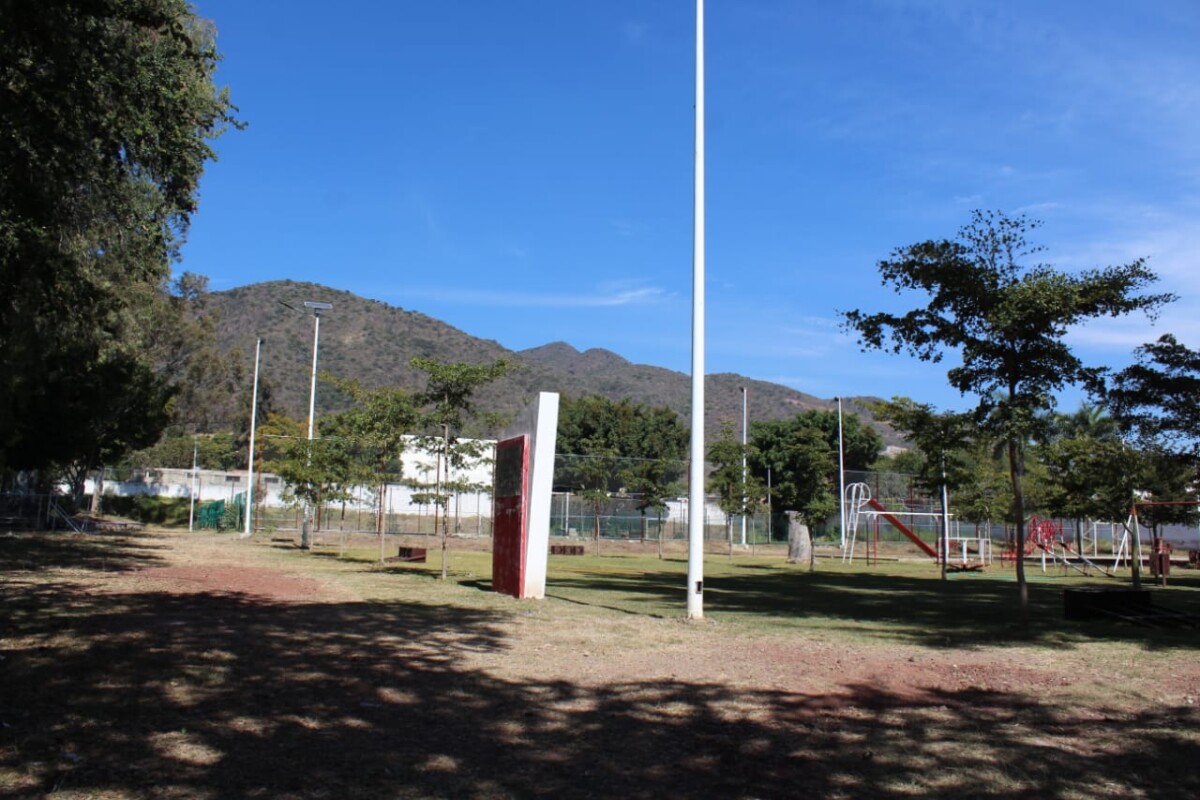
One of the projects is to finish the Ajijic Sports Unit, located in front of Los Carriles, in La Floresta.
He and the person in charge of sports in Ajijic, Alejandro González, are very enthusiastic about these works. They are also planning to maintain the soccer field located to the west of Ajijic in the area known as El Bajío, as well as the future construction of bathrooms in the area of La Cruz (at the end of Nicolas Bravo Street, where the Malecón corridor ends) and the cleaning of the lakeshore.
«We want to provide works that give good service to everyone, to have the areas of the square, the streets and the boardwalk ready and conditioned for everyone to go and enjoy, as well as to give attention to all Ajijic beyond the center. The president, the head of COMUDE (The Municipal Sports Council) Ajijic, and above all the people, are working together to achieve this,» declared Macias Arceo.

Colón Street, in the center of Ajijic, is a good example of the maintenance that the cobblestones of the streets of the Pueblo Mágico have received
Max added that for him, the most important thing is to reactivate sports and work with young people, carry out multiple cleaning campaigns and the creation of committees in the neighborhoods to have a more immediate communication.
Finally, he was asked if he would run in the town elections, to which he responded, «The future is uncertain and I could not say now if I would do it. If the people, because of my work, asked me to do so, I would do it. I would not make promises, I would base it on the actions and the work that has already been done. My stay in this position has always been to seek a positive change in Ajijic.»
Translated by Sydney Metrick
Ajijic’s Office Manager asks for people to keep streets and public spaces free of garbage and discarded junk
Cleanup of Emiliano Zapata street, where workers picked up debris, tires and an abandoned vending cart (Photo: Delegación Ajijic 2021-2024).
Sofía Medeles (Ajijic, Jal.)- After government workers clean Ajijic’s streets and removed handbills, armchairs, tires and even an abandoned vintage vehicle, the Head of Office of the Ajijic delegation, Maximiliano Max Macías Arceo asked people to stop discarding their trunks and garbage in the streets.
Max commented that in the last stretch they cleaned, Zapata Street from its intersection with Revolución, within two blocks the truck was full of tires, old chairs, and other junk thrown on the side of the street. The workers also cleaned the creek in the Ajijic Cemetery for the third time because people throw so much garbage in it. He added that the cleanup work will continue over the next few days.
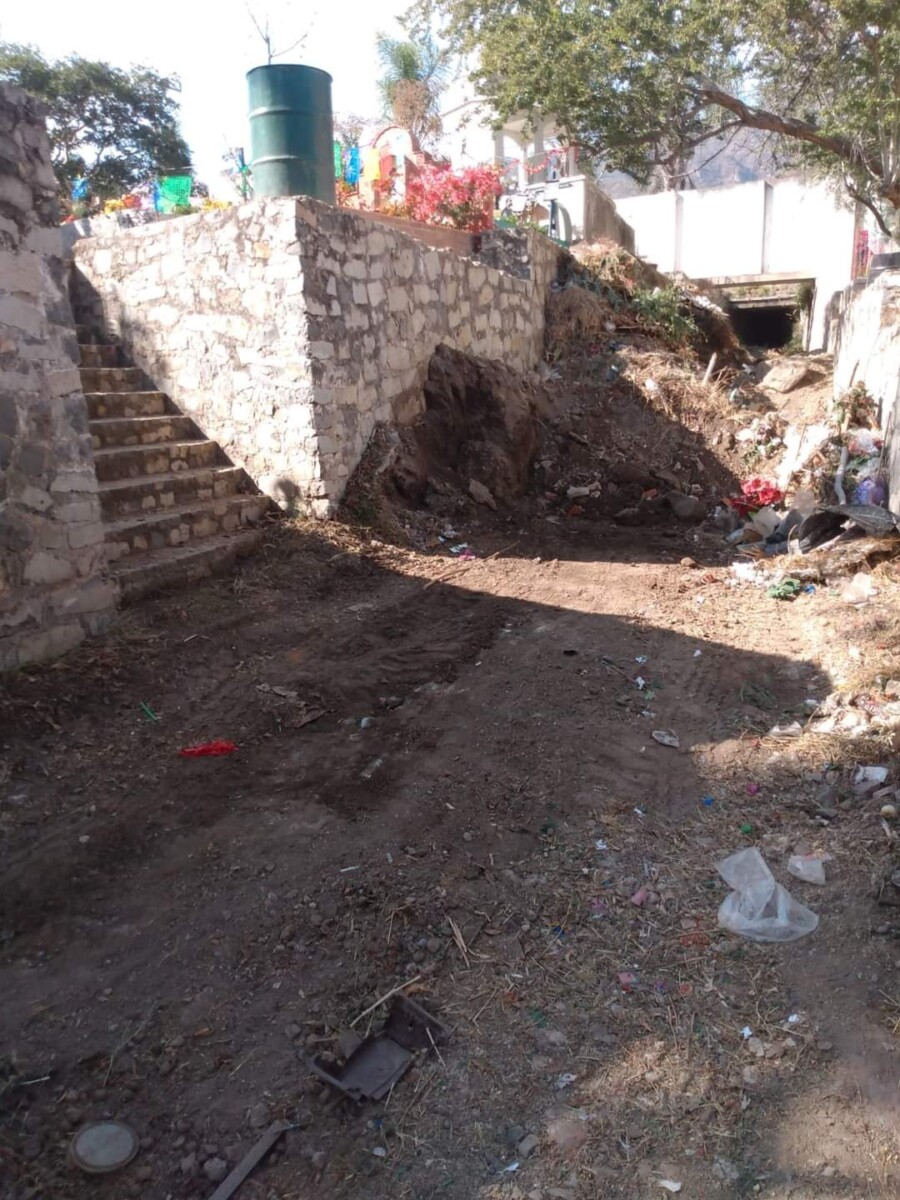
Stream next to the cemetery before being cleaned (Photo; Delegación Ajijic 2021-2024).
«In the case of the cemetery, a budget has already been requested for a gate because the creek is always open and used as a dumping ground for debris, garden garbage, and old furniture. The entrance of people will not be affected, only the creek will be closed, and signs posted with the number of the delegation for reports of this practice», commented Max.
He also e said that they have received many reports about the streets, requesting cleanings so he asked for the support of the residents to keep the streets clean for a long time.
«In some cases, it is cleaned, and a few days later, the garbage is back. This is because in some places the garbage bags are put outside before the truck passes, like the night before, and the stray dogs break the bags. So the next day the people from the truck only take the bags that are closed , forcing us to clean up garbage constantly. I ask for your support to remove the garbage in a timely manner,» he said.

Discarded armchairs in the street (Photo: Delegation Ajijic 2021-2024).
Max, said that if any inhabitant of the delegation needs to throw away tires, instead of taking them to the street, they should call the number of the delegation (33 3490 0382), so that they can be picked up for an amount of 10 pesos per tire, and they will be sent to Ecology Chapala which pays 12 pesos per tire for them to be discarded.
Likewise, for large items, such as furniture, the delegation offers the service, because it has authorization from the landfill to pick them up and take them to their final destination. He commented that the service is free, and to request it, they also have to call the number of the delegation.
Translated by Patrick O’Heffernan
© 2016. Todos los derechos reservados. Semanario de la Ribera de Chapala
